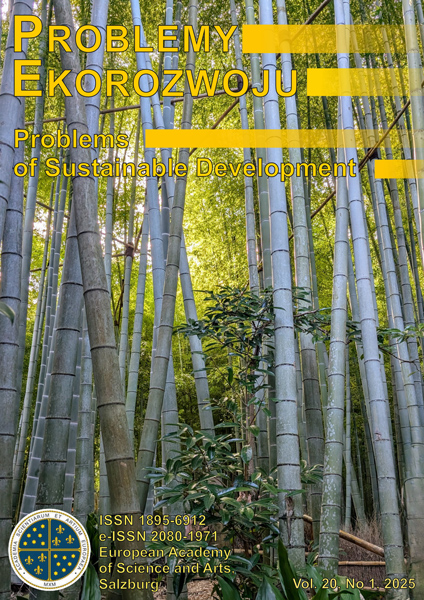Problematyka zrównoważonego rozwoju w świetle oceny geochemicznego stanu środowiska wodnego przy wykorzystaniu systemu GIS
Katarzyna Rozpondek
Czestochowa University of Technology, Faculty of Infrastructure and Environment, Dąbrowskiego 73, 42-201 Częstochowa, Poland (Polska)
Rafał Rozpondek
Czestochowa University of Technology, Faculty of Infrastructure and Environment, Dąbrowskiego 73, 42-201 Częstochowa, Poland (Polska)
Abstrakt
W pracy podjęto problematykę zrównoważonego rozwoju w świetle oceny geochemicznego stanu środowiska wodnego, koncentrując się na zanieczyszczeniach kumulujących się w osadach dennych. Analizę przeprowadzono w kontekście zawartości dziewięciu metali (As, Ba, Cd, Co, Cr, Cu, Ni, Pb i Zn). Klasyfikację pozyskanych wyników badań przeprowadzono na podstawie kryteriów geochemicznych. Rezultaty analiz odniesiono do wartości tła geochemicznego charakteryzującego warunki naturalne bez piętna antropopresji. Wykorzystując system GIS opracowano mapy przestrzennego rozkładu zanieczyszczeń wybranymi metalami ciężkimi (Ba, Cr, Cu, Ni, Pb i Zn), które pozwoliły na zaobserwowanie zależności pomiędzy badanymi elementami. Analiza zanieczyszczeń osadów dennych metalami ciężkimi jest istotnym narzędziem do monitoringu środowiska.
Przedstawione badania wykazały, że potencjalny poziom zanieczyszczeń w osadach dennych może osiągnąć znaczący poziom. Systematyczną kontrolą zawartości metali w osadach warto objąć jak największą ilość zbiorników wodnych. Umożliwi to zachowanie równowagi ekologicznej w ekosystemie środowisk wodnych. Działanie to pomoże w identyfikacji, likwidacji i zapobieganiu negatywnych skutków działalności gospodarczej człowieka, co poprawi istotne z punktu widzenia rozwoju zrównoważonego racjonalne użytkowanie zasobów środowiska naturalnego.
Słowa kluczowe:
zrównoważony rozwój, PMŚ, osady denne, metale ciężkie, GISBibliografia
BERDO J., 2006, Zrównoważony rozwój w stronę życia w harmonii z przyrodą (Sustainable development towards living in harmony with nature), in: Earth Conservation, p. 10-11.
Google Scholar
BOJAKOWSKA I., SOKOŁOWSKA G., 1998, Geochemiczne klasy czystości osadów wodnych (Geochemical purity classes for aquatic sediments), in: Przegląd Geologiczny, 46(1), p. 49-54.
Google Scholar
BOJAKOWSKA I., 2001, Kryteria oceny zanieczyszczenia osadów wodnych (Criteria for the assessment of contaminants in aquatic sediments), in: Przegląd Geologiczny 49(3), p. 213-218.
Google Scholar
EKOINFONET, 2016, http://ekoinfonet.gios.gov.pl/ (28.10.2016).
Google Scholar
GAŁKA B., WIATKOWSKI M., 2010, Metale ciężkie w wodzie i osadach dennych małego zbiornika wodnego Psurów (Heavy metals in water and sediments of a small reservoir in Psurów), in: Ochrona Środowiska i Zasobów Naturalnych, no 42.
Google Scholar
GEOMOR, 2016, http://www.geomor.com.pl/ (29.10.2016).
Google Scholar
HAZIK T., CZAPLICKA-KOTASZ A., ŚLUSARCZYK Z., SZALIŃSKA E., 2013, Przestrzenne zmiany stężeń cynku w osadach dennych Zbiornika Czorsztyńskiego (Spatial variations in zinc concentrations in the sediments of Czorsztyn Reservoir), in: Inżynieria i ochrona środowiska, 16(1), p. 57-68.
Google Scholar
KARWACKA A., NIEDZIELSKI P., STANISZEWSKI R., 2015, Ocena stanu osadów dennych wybranych jezior powiatu poznańskiego (Assessment of sedimentsof selected lakes in Poznań County), in: Rocznik Ochrona Środowiska/Annual Set Environment Protection vol. 17, pp. 1684-1698.
Google Scholar
KAZIMIEROWICZ Z., KAZMIEROWICZ J., 2014, Badania zawartości metali ciężkich w zlewni rzeki Biebrzy i jej trzech dopływów (A study of the heavy metals in the River Biebrz basin and its three tributaries), in: Inżynieria Ekologiczna vol. 40, p. 25-32.
Google Scholar
MIKSCH K., CEMA G., FELIS E., SOCHACKI A., 2015, Nowoczesne techniki i technologie inżynierii środowiska, in: Rocznik Ochrona Środowiska/Annual Set Environment Protection, vol. 11, p. 833-857.
Google Scholar
PAWŁOWSKI A., 2009, Teoretyczne uwarunkowania rozwoju zrównoważonego (Theoretical considerations of sustainable development), in: Rocznik Ochrona Środowiska/ Annual Set Environment Protection, vol 11, p. 985-994.
Google Scholar
PAWŁOWSKI L., 2011, Rola monitoringu środowiska w realizacji zrównoważonego rozwoju (The role of environmental monitoring in the implementation of sustainable development), in: Rocznik Ochrona Środowiska/ Annual Set Environment Protection vol. 13, p. 333-346.
Google Scholar
POLECHOŃSKI R., 2003, Ołów w ekosystemie jeziora Sława – przemieszczanie kumulacja oraz próba bilansu w dziesięcioleciu 1993- 2003 (Lead in Lake Sława’s ecosystem –cumulation transfer and an attempt for balance in the decade 1993-2003), in: Zesz. Nauk. Akademii Rolniczej we Wrocławiu nr 497, Rozprawy CCXXIII, Wrocław.
Google Scholar
ROZPONDEK R., WANCISIEWICZ K., 2016, Analiza rozkładu zanieczyszczeń w osadach dennych z zastosowaniem GIS w przybrzeżnej strefie zbiornika wodnego Ostrowy na rzece Biała Oksza (GIS-based analysis of the distribution of contaminants in the sediments along the shoreline of the Ostrowy Reservoir on the River Biała Oksza), in: Inżynieria i ochrona środowiska, vol. 19, no 1, p. 37-49.
Google Scholar
SOBCZYK W., BIEDRAWA-KOZIK A., KOWALSKA A., 2012, Threats to areas of natural interest, in: Rocznik Ochrona Środowiska/ The Annual Set Environment Protection, vol. 14, p. 262-273.
Google Scholar
TOMCZAK M, 1998, Spatial Interpolation and its Unceratinty Using Automated Anistropic Inverse Distance Weighting (IDW) – Cross-Validation/Jackknife Approach, in: Journal of Geographic Information and Decision Analysis, vol. 2, no 2, p. 18-30.
Google Scholar
VANDECASTEEL B., QUATAERT P., de VOS B., TACK F.M.G., 2004, Assessment of the pollution status of alluvial plains: a case study for the dredged sediment derived soils along the Leie River, in: Arch. Environ. Contam. Toxicol, vol. 47, p. 14-22.
Google Scholar
ZHANG C., SELINUS O., 1998, Statistics and GIS in environmental geochemistry – some problems and solutions, in: J. Geochemical Exploration, 64, p. 339-354.
Google Scholar
Autorzy
Katarzyna RozpondekCzestochowa University of Technology, Faculty of Infrastructure and Environment, Dąbrowskiego 73, 42-201 Częstochowa, Poland Polska
Autorzy
Rafał RozpondekCzestochowa University of Technology, Faculty of Infrastructure and Environment, Dąbrowskiego 73, 42-201 Częstochowa, Poland Polska
Statystyki
Abstract views: 17PDF downloads: 5
Licencja

Utwór dostępny jest na licencji Creative Commons Uznanie autorstwa – Na tych samych warunkach 4.0 Miedzynarodowe.




